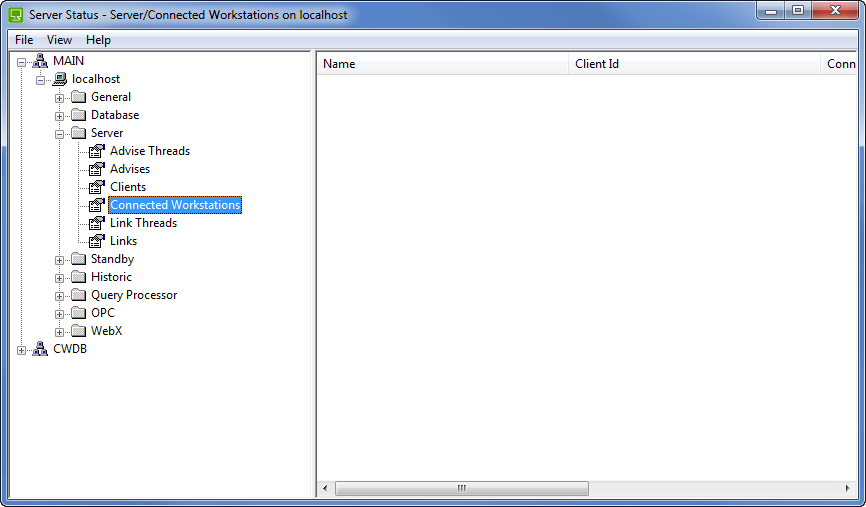The Workstation Name feature allows a single client PC to be allocated a unique name called the Workstation ID. The Workstation ID is used to identify the client along with its IP address. It allows alarm responses to be restricted to a specific client PC (only users that log on to the client with the required Workstation ID can respond to the alarms).
You can use the Server Status Tool to view status information about the clients with Workstation IDs that are currently connected to the Main server or a Standby server. The status information is shown on the Connected Workstations section of the Server category.

If the Server Status Tool is connected to the Main server, the Connected Workstations status shows all clients that are connected to the system, including those connected to Standby servers. However, if the Server Status Tool is connected to a Standby server, the Connected Workstations just displays information about the clients connected to that same Standby.
The Connected Workstations status information is categorized as:
- Name—The name of the connected work station. The workstation name is defined in the configuration of the client. For more information, see the ClearSCADA Guide to Client Administration.
- Client Id—The unique identity of the client, which usually consists of a combination of the client’s IP address and the session ID.
If the ViewX application is running on the client PC, the Client ID is 0 or 1 depending on the version of Windows.
The client ID is a unique number if ViewX is running on a server and is being accessed by clients using:
- Citrix
- Microsoft Remote Desktop
- Microsoft Remote Desktop Services (formerly Microsoft Terminal Services).
The unique session ID allows you to identify each client that is accessing the ViewX that is running on the server.
- Local—Indicates whether the client is connected to the same server as the Server Status Tool.
- Yes—The client and the Server Status Tool are both connected to the same server (which could be a Main or Standby server)
- No—The Server Status Tool is connected to the Main server and the client is connected to a Standby server.
- Standby 0—If the Server Status Tool is connected to the Main server, the Standby 0 column indicates whether the named client is connected to the first (or only) Standby server (Yes or No).
If the Server Status Tool is connected to a Standby server, the entry is blank ('-').
If your system does not have a Standby server, the entry is No.
- Standby 1—If the Server Status Tool is connected to the Main server, the Standby 1 column indicates whether the named client is connected to the second Standby server (Yes or No). The second Standby server could be a Permanent Standby server, depending on your system architecture.
If the Server Status Tool is connected to a Standby server, the entry is blank ('-').
If your system does not have a Standby server, the entry is No.
- Standby 2—If the Server Status Tool is connected to the Main server, the Standby 2 column indicates whether the named client is connected to the third Standby server (Yes or No). The third Standby server is a Permanent Standby server (it may be the first or second Permanent Standby server in your system, depending on the system architecture).
If the Server Status Tool is connected to a Standby server, the entry is blank ('-').
If your system does not have a Standby server, the entry is No.
- Standby 3—If the Server Status Tool is connected to the Main server, the Standby 3 column indicates whether the named client is connected to the fourth Standby server (Yes or No). The fourth Standby server is a Permanent Standby server (it may be the second or third Permanent Standby server in your system, depending on the system architecture).
If the Server Status Tool is connected to a Standby server, the entry is blank ('-').
If your system does not have a Standby server, the entry is No.
- Standby 4—If the Server Status Tool is connected to the Main server, the Standby 4 column indicates whether the named client is connected to the fifth Standby server (Yes or No). The fifth Standby server is a Permanent Standby server (it may be the third or fourth Permanent Standby server in your system, depending on the system architecture).
If the Server Status Tool is connected to a Standby server, the entry is blank ('-').
If your system does not have a Standby server, the entry is No.